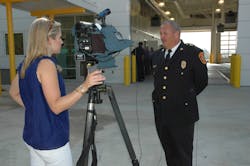“Ralph, I don’t know where you’re getting your s-s-s-s-statistics,” stammered Dick Harper, Jim Carey’s character in the movie “Fun with Dick and Jane.” Harper was thrilled to become the spokesperson for the huge conglomerate “Globodyne.” Unfortunately, he was set up by a crooked CEO (played deftly by Alec Baldwin) and woefully unprepared for the grilling he was going to get on national TV. You may or may not have seen this scene, but it’s a classic example of how an interview can go badly.
The prospect of an interview, especially one on TV, excites some public information officers (PIOs), and terrifies others. Both reactions are understandable. As is the case with most challenges, preparation makes all the difference in the world. So, with that in mind, here are some basic tips for new PIOs on media interviews.
Before the Interview
For starters, you need to know a few things. Who is the reporter? What’s the topic or issue? Will this be on camera? Do you know enough about the topic to talk about it, or do you need to bring in a Subject Matter Expert? For example, a PIO can easily offer basic fire prevention tips, but if a reporter wants to talk about what specific fire codes require the installation of sprinkler systems, then you should probably get someone in your department who can speak at length about fire codes.
The basic premise is this: know your material and be prepared for the interview. Going into an interview unprepared can result in a very bad experience, as Jim Carey so artfully demonstrated in that movie.
If however, you determine that the topic or issue does not apply to you or your department, you should politely decline the interview and redirect the reporter to the appropriate agency. If the request does apply to you, then get yourself ready.
Preparing for the Interview
Now that you know what the topic of the interview is, it’s time to gather the information you need. Whenever possible, it’s good to have more information than what’s needed for the interview. This reinforces the impression that you are credible and that you know what you’re talking about. Depending on the topic, you might print out a fact sheet or some background information that you can give to the reporter. That helps the reporter do his/her job, builds your reputation as a professional PIO, and boosts the odds that the reporter will get the story right.
Preparing Key Messages
The reporter wants something from you…information. Put aside the reporter for a moment. What do you want to happen from this interview? Is there anything you would really like the public to know? If so, prepare a few key points that can each be stated in roughly 15 seconds. In doing so you’ve just prepared “sound bites” for TV reporters. No matter how right you are about an issue, if you can’t pare it down to a sound bite or two, it won’t get used. No, that’s not fair, but that’s generally the way it works. Print reporters have more room for longer quotes, but they like short, “pithy,” statements too. A good way to prepare for the interview and those key messages is to practice beforehand, preferably with someone who can ask questions that will likely be asked by reporters.
Staying on Message
You may have heard the phrase “staying on message” from time to time. It has a somewhat negative connotation with reporters, because it implies that you might have something to hide. What I mean by staying on message is this: don’t allow the reporter to steer you in a direction you don’t want to go. For example, let’s say you’re on a hazmat scene and the reporter wants you to speculate on what could happen if a tank, or a certain chemical, explodes or spreads elsewhere. While the odds of this doomsday scenario may be low, just talking about it will make a good story on the 6 o’clock news and possibly scare the public into a frenzy. In refusing to speculate, you’re not hiding anything; you’re just not going to help a reporter scare everyone to death.
Instead, “bridge” back to your key points. “I’m not going to speculate on what might happen. What’s important right now is that we have hazmat technicians on the scene and they are working diligently to protect the public.” Bridging back to your own points is a key technique used by veteran PIOs. You can acknowledge the question, but very quickly bring it back to what you want the public to know. “Yes, this is a serious situation and I can assure you that we have responders on the scene right now who are working hard to eliminate the hazard.” With a statement like this, you’re acknowledging the question, but quickly bridging to your own message meant to reassure the public. And since a statement like that is roughly eight seconds long, you’ve created a sound bite, which makes it more likely that it will be used.
In my opinion, using the bridging technique is preferable to simply ignoring the question. If you do, you run the risk of appearing arrogant, and you may indeed give the impression that you’re hiding something. Viewers watching you ignore a reporter’s question on that hazmat scenario may well wonder if the situation is worse than you’re letting on. Bridging gives a nod to the question, and then quickly gets back to the information you want the public to have.
Take Charge of the Interview
As I said earlier, reporters want information from you. It’s your job to provide that information, but try to do so on your terms. Keep bridging back to your key messages. Use phrases such as “Our main concern is…” or “Our focus is….”
PIOs are no doubt the smartest, and most modest, people on earth. Still, there will be times when reporters ask questions for which you have no answer. Don’t panic. It’s okay to say you don’t know the answer, as long as you indicate that you will do your best to get an answer and get back to them as soon as possible. If that happens though, be sure you actually do get back to them. Otherwise, your credibility will take a hit. As I mentioned in a previous article, it takes a long time to build up your credibility as a professional PIO, but it takes no time at all to trash it beyond repair.
When you think you’ve answered a particularly tough question satisfactorily, shut up. Don’t fall for the reporter’s tactic of looking at you expectantly with the microphone in your face. Inexperienced PIOs, and many others, feel the need to fill the silence with additional comments. If you’ve answered the question, stop talking.
Don’t forget your body language and overall appearance, especially for television. If you’re being interviewed about the department getting a new fire truck, feel free to smile. If you’re talking about a fire fatality, you need to take on a more serious tone. Please avoid that “I’m just glad to be on TV” look, regardless of what you’re talking about. (TV news anchors are sometimes guilty of this too.) Your demeanor should match the situation.
When the interview appears to be over, don’t let your guard down. You’re still on the record and anything you say within earshot of the microphone or a reporter’s ear can and will be used against you. Obviously, there are many occasions when this is not the case, but you should keep this in mind as a matter of practice.
Much more could be said on this topic, but those are some of the basics on media interviews. In closing, here are some additional quick tips on media interviews:
- Anticipate what the reporter will ask and prepare accordingly.
- Don’t use firefighter jargon. Your information isn’t going to fellow firefighters. It’s going to the general public.
- Offer reliable information.
- If the information you offered is incorrect, correct the error and take responsibility for it.
- Don’t speculate, guess, assume or hypothesize.
- Don’t argue with a reporter.
- Don’t play favorites. Treat all reporters the same.
- Treat reporters with respect and they will usually respond in kind.
- Know reporters’ deadlines.
- Avoid “off-the-record” remarks.
- Don’t lose your cool.
- Don’t be intimidated.
- Monitor the news coverage that follows the interview to ensure its accuracy.
- Special TV Tips:
- a) Dress the part. Look professional
- b) Avoid simple “yes” or “no” answers. Elaborate a little, but get to the point.
- c) No sunglasses.
- d) No smoking or chewing.
- Never, ever lie!
Next time: Marketing Your Fire Department
BRUCE GARNER is the public information director for the Chattanooga Fire Department, a Class 2 ISO fire department in southeast Tennessee. He has a B.A. in English from Lee College (now Lee University) and was a former radio/TV reporter before switching to the other side of the microphone. After serving 10 years as a PIO with Hamilton County Emergency Services, he accepted his current position with the Chattanooga Fire Department, where he has been for the past 12 years. Utilizing his experience with emergency management, he has also served as chairman of the Hamilton County Local Emergency Planning Committee for six years, and is a member of the National Information Officers Association and Public Relations Society of America. You can reach him by e-mail at [email protected].
About the Author

Bruce Garner
Firehouse.com Contributor
Bruce Garner is the Public Information Director for the Chattanooga Fire Department, a Class 2 ISO fire department in southeast Tennessee. Bruce has a B.A. in English from Lee College (now Lee University) and was a former radio/TV reporter before switching to the other side of the microphone. After serving 10 years as a PIO with Hamilton County Emergency Services, he accepted his current position with the Chattanooga Fire Department, where he has been for the past 11 years. Utilizing his experience with emergency management, he has also served as chairman of the Hamilton County Local Emergency Planning Committee (LEPC) for six years, and is a member of the National Information Officers Association (NIOA) and Public Relations Society of America (PRSA). You can reach Bruce by e-mail at [email protected].
